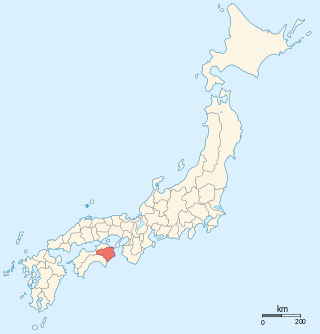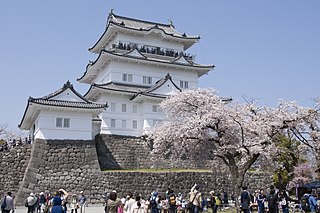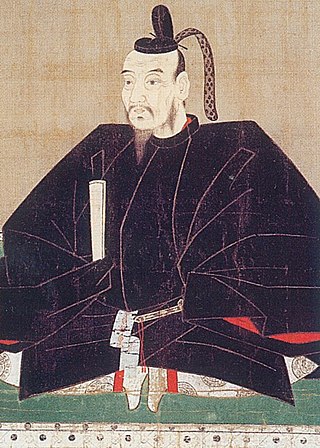
Toyotomi Hideyoshi, otherwise known as Kinoshita Tōkichirō and Hashiba Hideyoshi, was a Japanese samurai and daimyō of the late Sengoku and Azuchi-Momoyama periods and regarded as the second "Great Unifier" of Japan. Although he came from a peasant background, his immense power earned him the rank and title of Kampaku and Daijō-daijin, the highest official position and title in the nobility class. He was the first person in history to become a Kampaku who was not born a noble. He then passed the position and title of Kampaku to his nephew, Toyotomi Hidetsugu. He remained in power as Taikō (太閤), the title of retired Kampaku, until his death. It is believed, but not certain, that the reason he refused or could not obtain the title of shogun (征夷大将軍), the leader of the warrior class, was because he was of peasant origin.

Sanuki Province was a province of Japan in the area of northeastern Shikoku. Sanuki bordered on Awa to the south, and Iyo to the west. Its abbreviated form name was Sanshū (讃州). In terms of the Gokishichidō system, Sanuki was one of the provinces of the Nankaidō circuit. Under the Engishiki classification system, Sanuki was ranked as one of the "upper countries" (上国) in terms of importance, and one of the "middle countries" (中国) in terms of distance from the capital. The provincial capital was located in what is now the city of Sakaide, but its exact location was only identified in 2012. The ichinomiya of the province is the Tamura jinja located on the city of Takamatsu.

Awa Province was a province of Japan in the area that is today Tokushima Prefecture on the island of Shikoku. Awa was bordered by Tosa, Sanuki, and Iyo Provinces. Its abbreviated form name was Ashū (阿州). In terms of the Gokishichidō system, Awa was one of the provinces of the Nankaidō circuit. Under the Engishiki classification system, Awa was ranked as one of the 35 "superior countries" (上国) in terms of importance, and one of the "middle countries" (中国) in terms of distance from the capital. The provincial capital was located in what is now the city of Tokushima.

The third Siege of Odawara occurred in 1590, and was the primary action in Toyotomi Hideyoshi's campaign to eliminate the Hōjō clan as a threat to his power. The months leading up to it saw hasty but major improvements in the defense of the castle, as Hideyoshi's intentions became clear. Thus, despite the overwhelming force brought to bear by Hideyoshi, the siege saw little actual fighting.

The Invasion of Shikoku was a conflict of the Sengoku period of Japan fought between Toyotomi Hideyoshi and Chōsokabe Motochika on the island of Shikoku in 1585. Hideyoshi invaded Shikoku with a force of over 100,000 men in June and led a campaign against the Chōsokabe clan force of 40,000 men for control over the island. Hideyoshi's army was successful and conquered most of Shikoku within two months, and defeated Chōsokabe when he surrendered Ichinomiya Castle in August.

The Kyūshū campaign of 1586–1587 was part of the campaigns of Toyotomi Hideyoshi who sought to dominate Japan at the end of the Sengoku period. Having subjugated much of Honshū and Shikoku, Hideyoshi turned his attention to the southernmost of the main Japanese islands, Kyūshū.

Chōsokabe Motochika was a prominent daimyō in Japanese Sengoku-period. He was the 21st chief of the Chōsokabe clan of Tosa Province, the ruler of Shikoku region.

Chōsokabe clan, also known as Chōsokame (長宗我部), was a Japanese samurai kin group. Over time, they were known for serving the Hosokawa clan, then the Miyoshi clan and then the Ichijō clan.

Tosa Province was a province of Japan in the area of southern Shikoku. Tosa bordered on Awa to the northeast, and Iyo to the northwest. Its abbreviated form name was Doshū (土州). In terms of the Gokishichidō system, Tosa was one of the provinces of the Nankaidō circuit. Under the Engishiki classification system, Tosa was ranked as one of the "middle countries" (中国) in terms of importance, and one of the "far countries" (遠国) in terms of distance from the capital. The provincial capital was located in what is now the city of Nankoku. The ichinomiya of the province is the Tosa shrine located in the city of Kōchi.

Sumoto Castle was a Muromachi to Sengoku period Japanese castle located in the Orodani neighborhood of the city of Sumoto, Hyōgo Prefecture, Japan. Its ruins have been protected as a National Historic Site since 1999. It was also referred to as Mikuma Castle (三熊城).

Tokushima Castle was an Edo period Japanese castle located in the city of Tokushima, Tokushima Prefecture, Japan. Its ruins have been protected as a National Historic Site since 1957. Its Omotegoten Gardens are designated a national Place of Scenic Beauty.

Takaoka Castle was a flatland-style Japanese castle in what is now the city of Takaoka, Toyama Japan. It was originally constructed in 1609, and was only used for a few years before being dismantled. The site of its ruins are now a park. The castle is designated one of Japan's Top 100 Castles by the Japanese Castle Foundation. The ruins are protected as a National Historic Site.

Little is known of Sano Castle. It is mostly connected to its nearby castle, Karasawa Castle, both of which were next to Sano, the corresponding castle town for the two castles during the Edo period. The Sano Clan had previously built Karasawayama Castle, which had been established since the 1400s. In 1602, there was a great fire in Edo castle, which could be seen from Karasawayama Castle. The Sano clan sent their condolences to the Emperor. Some historians say that when the Emperor realised that Karasawayama Castle looked down on Edo, he told the Sano clan that there was a law against this. In the same year of the fire, 1602, the Sano clan, rebuilt another new castle at a lower point on the hill - this castle was named Sano Castle.

Amagiri Castle was a Muromachi period Japanese castle located on the border of what is now the cities of Zentsūji and Mitoyo and the town of Tadotsu, Kagawa Prefecture, Japan. Its ruins have been protected as a National Historic Site since 1990.

Okō Castle was a Japanese castle structure located in what is now part of the city of Nankoku Kōchi Prefecture, Japan. It was the original base of power for the Chōsokabe clan who were feudal lords of Tosa Province during the late Muromachi and Sengoku periods and famous as the birthplace of the warlord Chōsokabe Motochika. Its ruins have been protected as a National Historic Site since 2008.

Shōzui Castle was a Muromachi to Sengoku period Japanese castle located in the town of Aizumi, Itano District, Tokushima Prefecture, Japan. Its ruins have been protected as a National Historic Site since 2001, with the area under protection expanded in 2015.

Hiketa Castle was a Sengoku period Japanese castle located in what is now part of the city of Higashikagawa, Kagawa Prefecture, Japan. Its ruins have been protected by the central government as a National Historic Site since 2020.
Kōsokabe Chikayasu, third son of Chōsokabe Kunichika who was adopted by the Kōsokabe Clan in 1558 was a Japanese samurai of the Sengoku period, who served the Chōsokabe clan. He was the castle lord in command of Aki Castle. Throughout Chikayasu's life, he led many an army throughout his older brother Motochika's campaigns in Shikoku and contributing to the expansion of the domain of the Chōsokabe clan.
Kagomori Castle was a Sengoku period Japanese castle located in the Matsumaru neighborhood of the town of Matsuno, Ehime Prefecture, Japan. Its ruins have been protected as a National Historic Site since 1997.

The Ogasawara clan castle sites were a number Sengoku period yamashiro-style Japanese castles located in what is now part of the city of Matsumoto, Nagano prefecture. These fortifications were built in the Muromachi period by the Ogasawara clan, who ruled the area at the time. Two of the castle ruins, that of Igawa Castle and Hayashi Castle, have been protected collectively as a National Historic Sites since 2017.





















